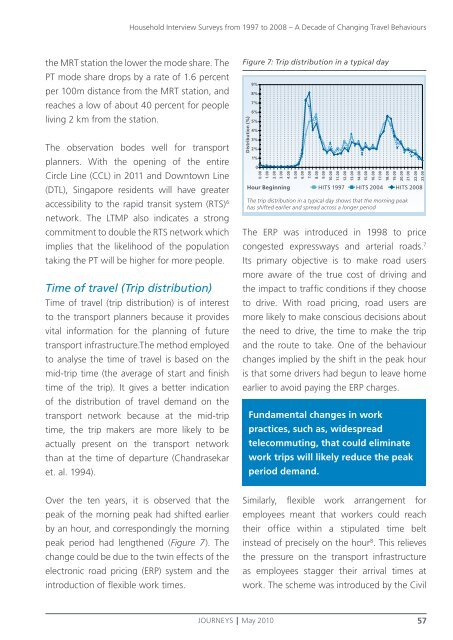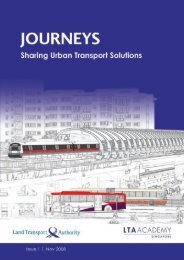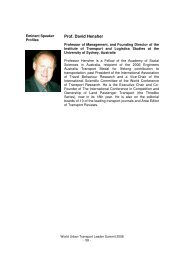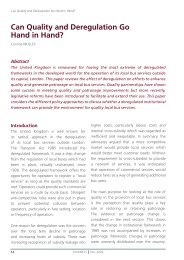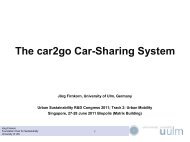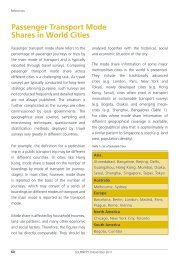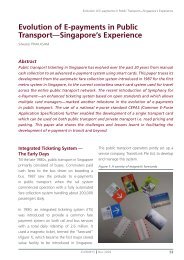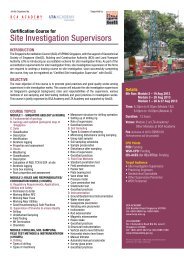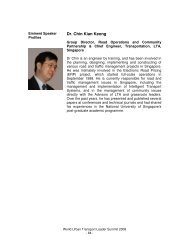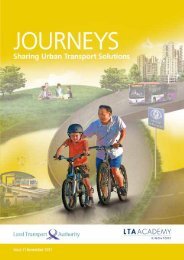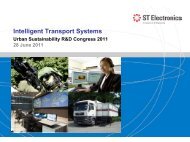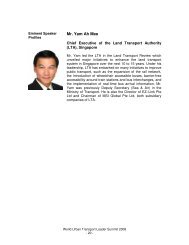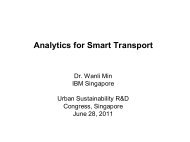Issue 4 May 2010 - LTA Academy
Issue 4 May 2010 - LTA Academy
Issue 4 May 2010 - LTA Academy
You also want an ePaper? Increase the reach of your titles
YUMPU automatically turns print PDFs into web optimized ePapers that Google loves.
Household Interview Surveys from 1997 to 2008 – A Decade of Changing Travel Behaviours<br />
the MRT station the lower the mode share. The<br />
PT mode share drops by a rate of 1.6 percent<br />
per 100m distance from the MRT station, and<br />
reaches a low of about 40 percent for people<br />
living 2 km from the station.<br />
The observation bodes well for transport<br />
planners. With the opening of the entire<br />
Circle Line (CCL) in 2011 and Downtown Line<br />
(DTL), Singapore residents will have greater<br />
accessibility to the rapid transit system (RTS) 6<br />
network. The LTMP also indicates a strong<br />
commitment to double the RTS network which<br />
implies that the likelihood of the population<br />
taking the PT will be higher for more people.<br />
Time of travel (Trip distribution)<br />
Time of travel (trip distribution) is of interest<br />
to the transport planners because it provides<br />
vital information for the planning of future<br />
transport infrastructure.The method employed<br />
to analyse the time of travel is based on the<br />
mid-trip time (the average of start and finish<br />
time of the trip). It gives a better indication<br />
of the distribution of travel demand on the<br />
transport network because at the mid-trip<br />
time, the trip makers are more likely to be<br />
actually present on the transport network<br />
than at the time of departure (Chandrasekar<br />
et. al. 1994).<br />
Over the ten years, it is observed that the<br />
peak of the morning peak had shifted earlier<br />
by an hour, and correspondingly the morning<br />
peak period had lengthened (Figure 7). The<br />
change could be due to the twin effects of the<br />
electronic road pricing (ERP) system and the<br />
introduction of flexible work times.<br />
Figure 7: Trip distribution in a typical day<br />
Distribution (%)<br />
9%<br />
8%<br />
7%<br />
6%<br />
5%<br />
4%<br />
3%<br />
2%<br />
1%<br />
0<br />
0.00<br />
1.00<br />
2.00<br />
3.00<br />
4.00<br />
5.00<br />
6.00<br />
7.00<br />
Hour Beginning HITS 1997 HITS 2004 HITS 2008<br />
The trip distribution in a typical day shows that the morning peak<br />
has shifted earlier and spread across a longer period<br />
The ERP was introduced in 1998 to price<br />
congested expressways and arterial roads. 7<br />
Its primary objective is to make road users<br />
more aware of the true cost of driving and<br />
the impact to traffic conditions if they choose<br />
to drive. With road pricing, road users are<br />
more likely to make conscious decisions about<br />
the need to drive, the time to make the trip<br />
and the route to take. One of the behaviour<br />
changes implied by the shift in the peak hour<br />
is that some drivers had begun to leave home<br />
earlier to avoid paying the ERP charges.<br />
Fundamental changes in work<br />
practices, such as, widespread<br />
telecommuting, that could eliminate<br />
work trips will likely reduce the peak<br />
period demand.<br />
Similarly, flexible work arrangement for<br />
employees meant that workers could reach<br />
their office within a stipulated time belt<br />
instead of precisely on the hour8 . This relieves<br />
the pressure on the transport infrastructure<br />
as employees stagger their arrival times at<br />
work. The scheme was introduced by the Civil<br />
JOURNEYS <strong>May</strong> <strong>2010</strong> 57<br />
8.00<br />
9.00<br />
10.00<br />
11.00<br />
12.00<br />
13.00<br />
14.00<br />
15.00<br />
16.00<br />
17.00<br />
18.00<br />
19.00<br />
20.00<br />
21.00<br />
22.00<br />
23.00


